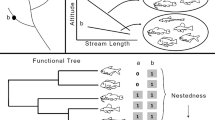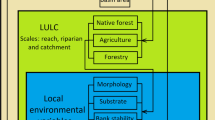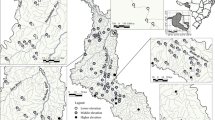Abstract
Channel slope is an important variable in lotic systems because it mediates flow. However, stream slope can be measured at various spatial scales and the relation with fish assemblage characteristics may be scale dependent. In this study we investigated the influence of stream slope measured at different spatial scales on fish species richness. We tested three hypotheses: 1) the relation between slope and species richness will be dependent on the spatial scale at which slope is measured; 2) species richness will be inversely related to mean stream slope; 3) species richness will be positively related to stream slope variability. We sampled riffle fish assemblages in 21 streams in southern Brazil. For each stream we measured slope at five different scales and calculated mean slope and slope variation. The influence of slope on local species richness was tested by simple regression analysis using rarefied richness as response variable. We found that the relation between slope and species richness was scale-dependent, because only slope at the whole stream channel was significantly related to species richness. We also observed that steeper streams tended to have less slope variability and lower species richness. These results suggest that processes occurring at the whole stream scale are determinant for local fish species richness. More importantly, they reinforce the need to measure slope at different scales when investigating fish-habitat relations in streams, because the influence of slope may not be detected if assessed at only one scale. We suggest that assessing mean slope and slope variability at different scales should be considered in sampling design of research and conservation aimed at stream fishes.



Similar content being viewed by others
References
Abell R, Thieme ML, Revenga C, Bryer M, Kottelat M, Bogutskaya N, Coad B, Mandrak N, Balderas SC, Bussing W, Stiassny MLJ, Skelton P, Allen GR, Unmack P, Naseka A, Ng R, Sindorf N, Robertson J, Armijo E, Higgins JV, Heibel TJ, Wikramanayake E, Olson D, Lopez HL, Reis RE, Lundberg JG, Perez MHS, Petry P (2008) Freshwater ecoregions of the world: a new map of biogeographic units for freshwater biodiversity conservation. Bioscience 58:403–414
Allan JD (2004) Landscapes and riverscapes: the influence of land use on stream ecosystems. Annu Rev Ecol Syst 35:257–284
Allan J, Johnson L (1997) Catchment-scale analysis of aquatic ecosystems. Freshwater Biol 37:107–111
Bae M, Kwon Y, Hwang S, Chon T, Yang H, Kwak I, Park J, Ham S, Park Y (2011) Relationships between three major stream assemblages and their environmental factors in multiple spatial scales. Ann Limnol-Int J Lim 47(suppl 1):91–105
Becker FG, Irgang GV, Hasenack H, Vilella FS, Verani NF (2004) Land cover and conservation state of a region in the Southern limit of the Atlantic Forest (river Maquiné basin, Rio Grande do Sul, Brazil). Braz J Biol 64:569–582
Benda L, Poff NL, Miller D, Dunne T, Reeves G, Pess G, Pollock M (2004) The network dynamics hypothesis: how channel networks structure riverine habitats. Bioscience 54:413–427
Cao Y, Hinz L, Metzke B, Stein JA, Holtrop AM (2015) Modeling and mapping fish abundance across wadeable streams of Illinois, USA based on landscape-level environmental variables. Can J Fish Aquat Sci. doi:10.1139/cjfas-2015-0343
Casatti L, Castro R (2006) Testing the ecomorphological hypothesis in a headwater riffles fish assemblage of the rio São Francisco, southeastern Brazil. Neotrop Ichthyol 4:203–214
Casatti L, Langeani F, Silva AM, Castro RMC (2006) Stream fish, water and habitat quality in a pasture dominated basin, southeastern Brazil. Braz J Biol 66:681–696
Casatti L, Ferreira CP, Langeani F (2009) A fish-based biotic integrity index for assessment of lowland streams in southeastern Brazil. Hydrobiologia 623:173–189
Chanson H (2004) Environmental hydraulics for open channel flows. Butterworth-Heinemann, Oxford
Chun SN, Cocherell SA, Cocherell DE, Miranda JB, Jones GJ, Graham J, Cech JJ Jr (2011) Displacement, velocity preference, and substrate use of three native California stream fishes in simulated pulsed flows. Environ Biol Fish 90:43–52
Dauwalter DC, Splinter DK, Fisher WL, Marston RA (2008) Biogeography, ecoregions, and geomorphology affect fish species composition in streams of eastern Oklahoma, USA. Environ Biol Fish 82:237–249
Davies PE, Nelson M (1993) The effect of steep slope logging on fine sediment infiltration into the beds of ephemeral and perennial streams of the Dazzler Range, Tasmania, Australia. J Hydrol 150:481–504
Development Core Team R (2015) R: a language and environment for statistical computing. R Foundation for Statistical Computing, Vienna, https://www.r-project.org. Accessed 13 April 2015
Elliott JM (2000) Pools as refugia for brown trout during two summer droughts: trout responses to thermal and oxygen stress. J Fish Biol 56:938–948
Ernesto M, Pacca IG, Hiodo FY, Nardy AJR (1990) Palaeomagnetism of the Mesozoic Serra Geral formation, southern Brazil. Phys Earth Planet In 64:153–175
ESRI (2013) ArcGIS Desktop 10.2. New York, USA
Fausch KD, Torgersen CE, Baxter CV, Li HW (2002) Landscapes to riverscapes: bridging the gap between research and conservation of stream fishes. Bioscience 52:483–498
Fernandez Luque R, Van Beek R (1976) Erosion and transport of bed-load sediment. J Hydraul Res 14:127–144
Frissel CA, Lis WJ, Warren CE, Hurley MD (1986) A hierarchical framework for stream habitat classification: viewing streams in a watershed context. Environ Manage 10:199–214
Gido KB, Falke JA, Oakes RM, Hase KJ (2006) Fish-habitat relations across spatial scales in prairie streams. Am Fish S S 48:265–285
Gordon ND, Finlayson BL, McMahon TA (2004) Stream hydrology: an introduction for ecologists. John Wiley and Sons
Grenouillet G, Pont D, Hérissé C (2004) Within-basin fish assemblage structure: the relative influence of habitat versus stream spatial position on local species richness. Can J Fish Aquat Sci 61:93–102
Harvey BC (1987) Susceptibility of young-of-the-year fishes to downstream displacement by flooding. T Am Fish Soc 116:851–855
Hasenack H, Weber E (2010) Base cartográfica vetorial contínua do Rio Grande do Sul - escala 1:50.000. Porto Alegre, Brazil
Hitt NP, Angermeier PL (2008) Evidence for fish dispersal from spatial analysis of stream network topology. J N Am Benthol Soc 27:304–320
Kaufmann PR, Hughes RM (2006) Geomorphic and anthropogenic influences on fish and amphibians in Pacific Northwest coastal streams. Am Fish S S 48:429–455
Kilgour BW, Barton DR (1999) Associations between stream fish and benthos across environmental gradients in southern Ontario, Canada. Freshwater Biol 41:553–566
Kilgour BW, Stanfield LW (2006) Hindcasting reference conditions in streams. Am Fish S S 48:623–639
Lake PS (2000) Disturbance, patchiness, and diversity in streams. J N Am Benthol Soc 19:573–592
Lake PS (2003) Ecological effects of perturbation by drought in flowing waters. Freshwater Biol 48:1161–1172
Leathwick JR, Snelder T, Chadderton WL, Elith J, Julian K, Ferrier S (2011) Use of generalised dissimilarity modelling to improve the biological discrimination of river and stream classifications. Freshwater Biol 56:21–38
Magoulick DD, Kobza RM (2003) The role of refugia for fishes during drought: a review and synthesis. Freshwater Biol 48:1186–1198
Miyazono S, Taylor CM (2013) Effects of habitat size and isolation on species immigration–extinction dynamics and community nestedness in a desert river system. Freshwater Biol 58:1303–1312
Moerke AH, Lamberti GA (2003) Responses in fish community structure to restoration of two Indiana streams. N Am J Fish Manage 23:748–759
Myrick CA, Cech JJ Jr (2000) Temperature influences on California rainbow trout physiological performance. Fish Physiol Biochem 22:245–254
Oksanen J, Kindt R, Legendre P, O’hara B, Stecens MHH, Oksanen MJ, Suggests M (2007) The vegan package. Oulu, Finland
Oliveira JM, Segurado P, Santos JM, Teixeira A, Ferreira MT, Cortes RV (2012) Modelling stream-fish functional traits in reference conditions: regional and local environmental correlates. PLoS ONE 7:e45787
Osborne LL, Wiley MJ (1992) Influence of tributary spatial position on the structure of warmwater fish communities. Can J Fish Aquat Sci 49:671–681
Pearsons TN, Li HW, Lamberti GA (1992) Influence of habitat complexity on resistance to flooding and resilience of stream fish assemblages. T Am Fish Soc 121:427–436
Poff NL (1997) Landscape filters and species traits: towards mechanistic understanding and prediction in stream ecology. J N Am Benthol Soc 73:391–409
Quist MC, Hubert WA, Rahel FJ (2006) Concurrent assessment of fish and habitat in warmwater streams in Wyoming. Fisheries Manage Ecol 13:9–20
Resh VH, Brown AV, Covich AP, Gurtz ME, Li HW, Minshall GW, Reice SR, Sheldon AL, Wallace JG, Wissmar RC (1988) The role of disturbance in stream ecology. J N Am Benthol Soc 7:433–455
Rice SP, Greenwood MT, Joyce CB (2001) Tributaries, sediment sources, and the longitudinal organisation of macroinvertebrate fauna along river systems. Can J Fish Aquat Sci 58:824–840
Rice SP, Ferguson RI, Hoey TB (2006) Tributary control of physical heterogeneity and biological diversity at river confluences. Can J Fish Aquat Sci 63:2553–2566
Richards C, Haro R, Johnson L, Host G (1996) Catchment and reach-scale properties as indicators of macroinvertebrate species traits. Freshwater Biol 37:219–230
Rosgen DL (1994) A classification of natural rivers. Catena 22:169–199
Santoul F, Soulard A, Figuerola J, Céréghino R, Mastrorillo S (2004) Environmental factors influencing local fish species richness and differences between hydroregions in South-Western France. Int Rev Hydrobiol 89:79–87
Schlosser JI (1995) Critical landscape attributes that influence fish population dynamics in headwater streams. Hydrobiologia 303:71–81
Sedell JR, Reeves GH, Hauer FR, Stamnford JA, Haekins CP (1990) Role of refugia in recovery from disturbances: modern fragmented and disconnected river systems. Environ Manage 14:711–724
Stanfield LW, Gibson SF, Borwick JA (2006) Using a landscape approach to identify the distribution and density patterns of salmonids in Lake Ontario tributaries. Am Fish S S 48:601–622
Strahler AN (1957) Quantitative analysis of watershed geomorphology. Eos, Trans Amer Geophys Union 38:913–920
Taylor CM (1997) Fish species richness and incidence patterns in isolated and connected stream pools: effects of pool volume and spatial position. Oecologia 110:560–566
Thornbrugh DJ, Gido KB (2009) Influence of spatial positioning within stream networks on fish assemblage structure in the Kansas River basin, USA. Can J Fish Aquat Sci 67:143–156
Tomazelli LJ, Dillenburg SR, Villwock JA (2000) Late Quaternary geological history of Rio Grande do Sul coastal plain, southern Brazil. Braz J Geol 30:474–476
Townsend CR, Dolédec S, Norris R, Peacock K, Arbuckle C (2003) The influence of scale and geography on relationships between stream community composition and landscape variables: description and prediction. Freshwater Biol 48:768–785
Walters DM, Leigh DS, Freeman MC, Freeman BJ, Pringle CM (2003) Geomorphology and fish assemblages in a Piedmont river basin, USA. Freshwater Biol 48:1950–1970
Wang L, Lyons J, Kanehl P (2002) Effects of watershed best management practices on habitat and fish in Wisconsin streams. J Am Water Resour As 38:663–680
Acknowledgments
We are grateful to Taís F. R. Guimarães and Bruna A. Meneses for helping with GIS and for insightful discussions, and to all colleagues of the Landscape Ecology Lab that helped in field work. M. Camana received a UFRGS/CNPQ-BIC scholarship during this research project and R.B. Dala-Corte received a student scholarship from the Coordenação de Aperfeiçoamento de Pessoal de Nível Superior (CAPES).
Author information
Authors and Affiliations
Corresponding author
Rights and permissions
About this article
Cite this article
Camana, M., Dala-Corte, R.B. & Becker, F.G. Relation between species richness and stream slope in riffle fish assemblages is dependent on spatial scale. Environ Biol Fish 99, 603–612 (2016). https://doi.org/10.1007/s10641-016-0502-0
Received:
Accepted:
Published:
Issue Date:
DOI: https://doi.org/10.1007/s10641-016-0502-0




